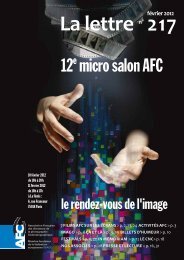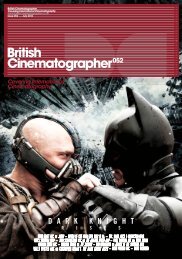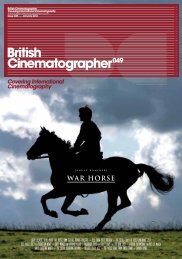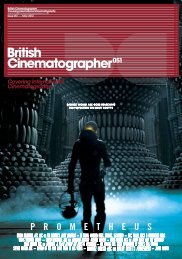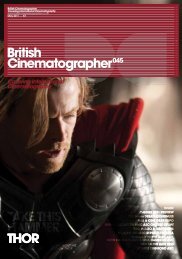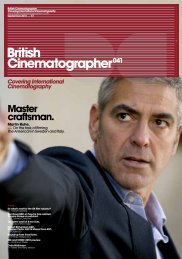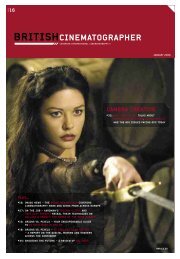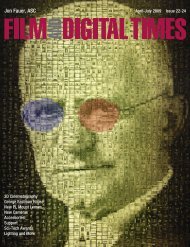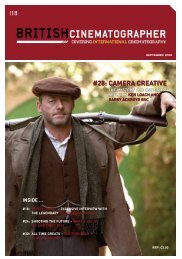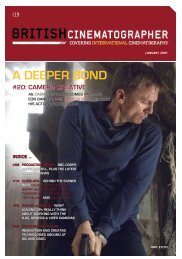You also want an ePaper? Increase the reach of your titles
YUMPU automatically turns print PDFs into web optimized ePapers that Google loves.
Sony PMW-F3<br />
This is not a tape measure<br />
hook at the image plane: it is a<br />
carrying strap hook.<br />
Cooke /i lens<br />
contacts at 12<br />
o’clock.<br />
Image plane<br />
Rocker control for<br />
zoom lenses<br />
PL mount has<br />
contacts for lens<br />
data at the 12 and 3<br />
o’clock positions.<br />
ZEISS/ARRI LDS<br />
lenses have<br />
contacts normally<br />
positioned at 3<br />
o’clock.<br />
The new Sony PMW-F3 camcorder is another step in the<br />
democratization of cinematography—a 35mm format digital<br />
camcorder that is lighter, smaller, faster, cheaper. Unveiled as an<br />
“affordable 35” prototype at NAB, it was introduced at USC on<br />
November 17th with film students and independents in mind.<br />
But its appeal is greater. The body weighs a meager 5.3 lbs (2.4<br />
kg). Many lenses weigh more: instead of attaching a lens on this<br />
camera, you’ll often put the camera on a lens. (See lens charts<br />
later in this issue.) Power consumption is an astonishingly low 24<br />
Watts. The Sony F3 uses an on-board 12 volt battery like the BPU-<br />
60 for about 3 hours of run-time. There are no fans.<br />
The PMW-F3 camcorder has a Super 35mm single CMOS sensor:<br />
23.6 x 13.3 mm, which is close to 35mm 3-perf 1.77:1 motion<br />
picture format. The newly developed Sony Exmor CMOS imager<br />
promises high sensitivity and low noise levels. The ballpark<br />
sensitivity rating is ISO 800 (1600 in S-log), with an exposure<br />
range greater than 13 stops. Up to now, Sony has been using<br />
CCDs for digital motion picture camcorders. Since image sensors<br />
for motion picture production must consider characteristics such<br />
as sensitivity, dynamic range, and smoothness of motion—by<br />
enlarging the size of each pixel in the new Exmor CMOS sensor,<br />
Sony achieved high sensitivity, low noise, and good image quality.<br />
Looking at the front, you notice two distinctive things. The F3<br />
has a PL mount. But it’s really an adaptor. Remove it by turning<br />
the mounting ring on the body counter-clockwise. Underneath<br />
is a new stainless-steel Sony F3 mount. It is a little wider than a<br />
PL, and reminiscent of Sony EX3 mounts. The flange focal depth<br />
is remarkably shallow, which translates into lenses that are easier<br />
to build, non-retrofocus, (think Leica M series rangefinder) and<br />
best of all, opens up the world of adaptors. And, as if to prove this<br />
point, every PMW-F3 camera ships with a Sony F3 to PL mount<br />
adaptor. The PL mount has lens contacts in place for Cooke /i<br />
Technology and ARRI LDS.<br />
What does this all mean? Alfred Piffl may have predicted correctly:<br />
it’s not just a PL mount camera world; cameras can now have<br />
infinite choices of 35mm format interchangeable mounts. The<br />
DSLR revolution confirmed the appeal of larger single sensors<br />
with their shallower depth of field.<br />
The PWM-F3L package is the basic camera with PL adaptor—no<br />
lenses—with a list price around $16,000. The PMW-F3K package<br />
consists of the camera, PL adaptor, and 3 Sony PL Primes: 35, 50,<br />
and 85 mm T2.0. This kit will cost around $23,000. The PL lenses<br />
will support Cooke /i Technology. We also learned that Sony is<br />
planning an affordable zoom lens with the Sony F3 mount (not<br />
PL). The shorter flange depth should enable this lens to be smaller<br />
and lighter than current PL zooms.<br />
The PMW-F3 is based on the XDCAM EX platform. This is Sony’s<br />
third 35mm CineAlta <strong>Digital</strong> Camcorder. The other two are F35<br />
and SRW-9000PL. Their specs still exceed the F3, but this camera<br />
is no slouch, and footage shot with all 3 cameras should intercut.<br />
The F3, above all, is a handheld camcorder. It doesn’t sit on<br />
your shoulder. You hold it like a Handycam, slipping your hand<br />
between the prosumer/video style adjustable strap and plastic<br />
handle with its zoom rocker control and start/stop button. It’s not<br />
a shoulder-resting camera. The lighter and smaller camera body<br />
was made possible by the development of the new CMOS sensor,<br />
Dec 2010<br />
21



